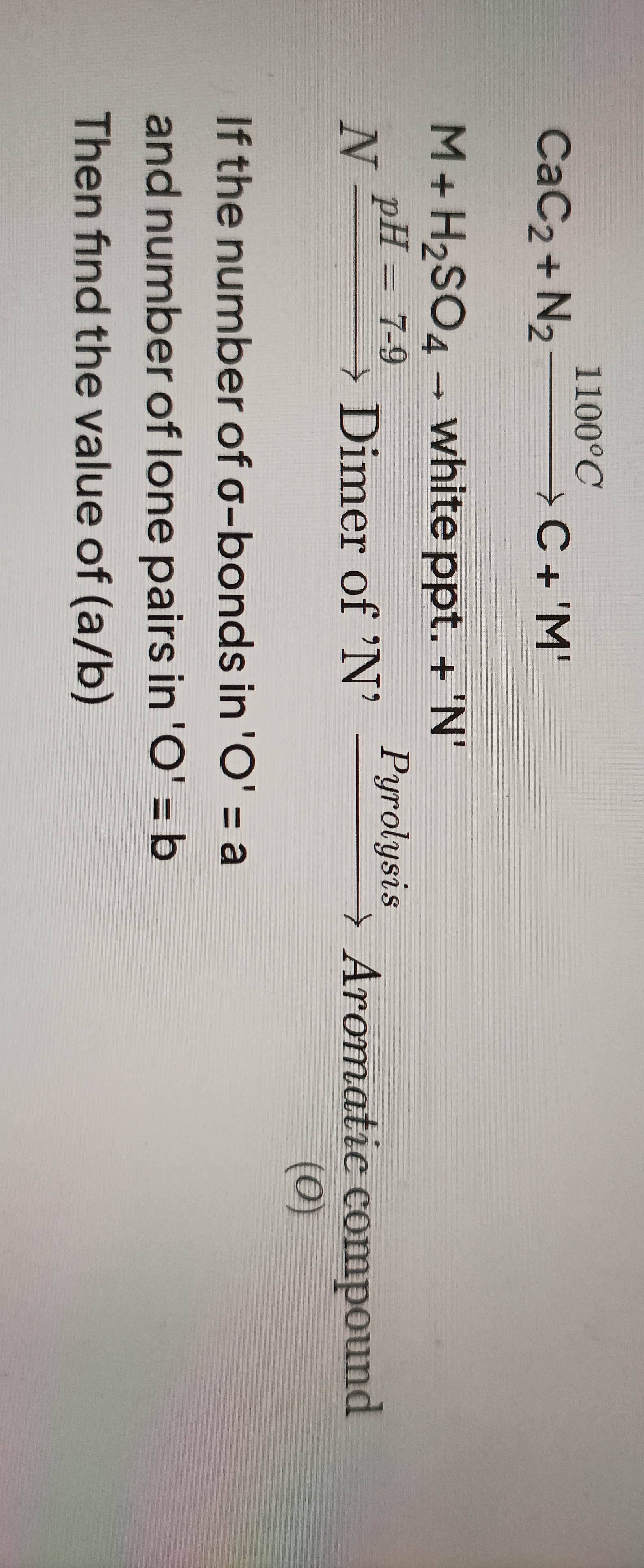Question
Question: $CaC_2 + N_2 \xrightarrow{1100^\circ C} C + 'M'$ $M + H_2SO_4 \rightarrow$ white ppt. + 'N' $N \xr...
CaC2+N21100∘CC+′M′
M+H2SO4→ white ppt. + 'N'
NpH=7−9 Dimer of 'N' Pyrolysis Aromatic compound (O)
If the number of σ-bonds in 'O' = a and number of lone pairs in 'O' = b
Then find the value of (a/b)

2.5
Solution
Solution: The given reactions are:
-
CaC2+N21100∘CC+′M′ This is the Frank-Caro process for producing calcium cyanamide. CaC2+N21100∘CCaCN2+C So, 'M' is CaCN2 (Calcium cyanamide) and 'C' is Carbon.
-
M+H2SO4→ white ppt. + 'N' 'M' is CaCN2. Calcium cyanamide reacts with acid to form cyanamide and a calcium salt. CaCN2+H2SO4→CaSO4↓+H2NCN CaSO4 (Calcium sulfate) is a white precipitate. So, 'N' is H2NCN (Cyanamide).
-
NpH=7−9 Dimer of 'N' Pyrolysis Aromatic compound (O) 'N' is H2NCN (Cyanamide). Cyanamide dimerizes at pH 7-9 to form dicyandiamide (cyanoguanidine). 2H2NCNpH=7−9(H2N)2C=N−C≡N The dimer of 'N' is dicyandiamide. Pyrolysis of dicyandiamide yields melamine, which is an aromatic compound. 3(H2N)2C=N−C≡NPyrolysis2C3H6N6 The aromatic compound 'O' is Melamine (C3H6N6).
Melamine has the structure 1,3,5-triazine-2,4,6-triamine:
NH₂
/ \
C N
/ \
N C
// \\
N N
\ /
C---N---C
| | |
NH₂ NH₂ NH₂
Melamine is an aromatic compound (planar ring, cyclic delocalization of 6 π electrons, follows Huckel's rule).
We need to find the number of σ-bonds (a) and the number of lone pairs (b) in Melamine (O).
Number of σ-bonds (a):
- Ring σ-bonds: The six-membered ring has 6 atoms (3 C and 3 N) connected by single and double bonds. Counting one bond from each double bond and all single bonds in the ring skeleton gives 6 σ-bonds in the ring.
- Exo-cyclic C-N σ-bonds: There are 3 amino groups (NH2) attached to the carbon atoms of the ring. Each C-NH2 bond is a single bond. So, 3 C-N σ-bonds.
- N-H σ-bonds: Each NH2 group has 2 N-H single bonds. There are 3 NH2 groups. So, 3×2=6 N-H σ-bonds.
Total number of σ-bonds (a) = 6 (ring) + 3 (C-N) + 6 (N-H) = 15.
Number of lone pairs (b):
- Ring Nitrogen atoms: There are 3 nitrogen atoms in the ring. Each ring nitrogen is bonded to two carbon atoms and has one lone pair contributing to the aromatic system. So, 3 lone pairs on ring nitrogens.
- Exo-cyclic Nitrogen atoms (NH2 groups): There are 3 nitrogen atoms in the NH2 groups. Each NH2 nitrogen is bonded to one carbon and two hydrogen atoms, and has one lone pair. So, 3 lone pairs on NH2 nitrogens.
Total number of lone pairs (b) = 3 (ring N) + 3 (NH2 N) = 6.
We need to find the value of (a/b). a = 15 b = 6 (a/b) = 15 / 6 = 5 / 2 = 2.5
The final answer is 2.5.
